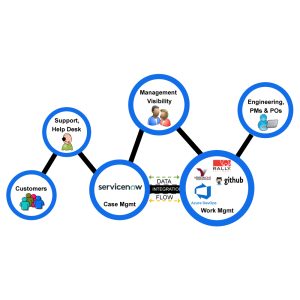Automation in financial services has evolved from being a tool for efficiency to a strategic enabler of business transformation. As financial institutions face increasing pressure from regulatory bodies, rising customer expectations, and competitive digital disruptors, automation is redefining how they operate. This blog delves into the advanced impact of automation on accuracy and speed in financial services, exploring real-world applications, innovations, and strategies for long-term success.
In an industry where precision, security, and speed are paramount, automation allows financial institutions to meet these demands at scale. Financial services are heavily reliant on vast data streams, complex processes, and regulatory compliance areas where automation not only enhances accuracy but also speeds up decision-making.
As automation technologies continue to advance, they enable financial institutions to process transactions in real-time, identify risks with greater precision, and offer personalized customer experiences that were once deemed impossible. The ability to seamlessly integrate automation into core functions is no longer just a competitive advantage; it’s becoming an essential element for survival in the modern financial landscape.
1. Transforming Back-Office Operations: Beyond Efficiency
Back-office automation in financial services is no longer about merely cutting costs. It’s about redefining operational agility.
Innovations in Back-Office Automation:
- Intelligent Process Automation (IPA): Unlike traditional RPA, IPA combines artificial intelligence and machine learning to handle exceptions, adapt to new scenarios, and continuously improve processes.
- Dynamic Workflows: Systems now dynamically route tasks based on priorities, compliance requirements, and SLAs, ensuring timely resolution of complex cases.
Strategic Value:
- Predictive Capabilities: Advanced systems predict operational bottlenecks and address them proactively.
- Regulatory Reporting: Automation ensures compliance with intricate financial reporting standards like IFRS 9 and Basel III, reducing penalties and enhancing transparency.
For example, a Major Bank’s deployment of IPA improved operational accuracy by 75%, drastically reducing time spent on reconciliations and reporting.
2. Advanced Fraud Detection and Prevention: Machine Learning in Action
Fraud detection is no longer reactive; it’s predictive and preemptive, thanks to machine learning and advanced analytics.
Cutting-Edge Technologies:
- Graph-Based Fraud Detection: Systems analyze transactional relationships, uncovering hidden fraud rings and suspicious patterns.
- Real-Time Behavioral Analysis: AI monitors user behavior to detect anomalies, such as unusual login locations or transaction volumes, flagging risks instantaneously.
Strategic Insights:
- Reduced False Positives: Machine learning algorithms adapt and refine themselves, minimizing false alarms and improving operational efficiency.
- Holistic Risk Mitigation: Integrating fraud detection across channels—mobile, online, and ATM—ensures a unified risk management approach.
Case studies show that implementing advanced AI-based fraud detection systems can reduce financial losses by up to 40%.
3. Hyper-Personalization: The New Standard in Customer Experience
Today’s financial customers expect services tailored to their unique needs. Automation powered by advanced data analytics enables hyper-personalization at scale.
Advanced Applications:
- Behavioral Segmentation: AI clusters customers based on behavior, enabling targeted product offerings.
- Predictive Assistance: Virtual assistants provide proactive financial advice, such as alerts about potential overdrafts or investment opportunities.
- Integrated Ecosystems: Automated systems link financial services with third-party platforms, creating a seamless experience (e.g., real-time mortgage offers while browsing properties).
Business Impact:
- Increased Cross-Sell Rates: Personalized recommendations lead to higher adoption of complementary services.
- Customer Retention: Personalized interactions build loyalty and reduce churn.
AI-driven personalization initiatives have increased customer engagement by 35% within their wealth management division.
4. Compliance Automation: Moving from Reactive to Proactive
Financial institutions face constant regulatory scrutiny, making compliance automation critical not only for adherence but also for strategic planning.
Sophisticated Tools:
- Natural Language Processing (NLP): Tools that scan, interpret, and apply regulatory updates automatically to organizational policies.
- Regulatory Sandboxes: Automated environments simulate compliance scenarios, enabling preemptive adjustments.
- Blockchain for Audits: Immutable ledgers ensure compliance traceability, enhancing trust and reducing audit complexities.
Strategic Leverage:
- Reduced Audit Costs: Automation streamlines audit preparations, cutting down expenses and manual effort.
- Future-Ready Compliance: AI models predict regulatory trends, enabling proactive adaptation to upcoming mandates.
For example, a company reduced compliance-related overheads by 20% within the first year of adopting automation for global reporting.
5. Operational Scalability with Cloud-Based Automation
Automation combined with cloud infrastructure is enabling financial institutions to scale operations without proportional cost increases.
Innovations Driving Scalability:
- Microservices Architecture: Modular systems allow financial firms to integrate and scale specific functions independently.
- API-Driven Ecosystems: APIs enable seamless collaboration between internal systems and external partners, extending service reach.
Long-Term Benefits:
- Rapid Market Entry: Launching new services or entering new geographies becomes faster and more cost-effective.
- Elastic Resource Allocation: Cloud-based automation adjusts resource usage dynamically, optimizing costs.
6. Addressing Challenges: Practical Solutions
Common Barriers:
- Legacy System Dependence: Financial institutions often struggle with integrating new automation tools into outdated systems.
- Data Privacy and Security: Automation increases data flow across systems, raising the risk of breaches.
How to Overcome Them:
- Phased Implementation: Start with high-impact areas and gradually expand automation efforts.
- Zero Trust Architecture: Implement advanced security frameworks to protect sensitive financial data.
- Upskilling Initiatives: Train staff to manage and optimize automation tools, ensuring seamless human-machine collaboration.
Conclusion: Nexright Commitment to Financial Transformation
Automation is reshaping financial services by elevating accuracy, speed, and strategic capabilities. Whether it’s enhancing back-office operations, driving fraud detection, or delivering hyper-personalized customer experiences, the potential is immense.
At Nexright, we don’t just provide automation solutions—we partner with financial institutions to build resilient, scalable, and future-ready systems. Our expertise lies in helping organizations overcome implementation challenges and achieve measurable results.
Transform your financial operations today. Partner with Nexright to lead the automation revolution in financial services. Contact us to begin your journey.




